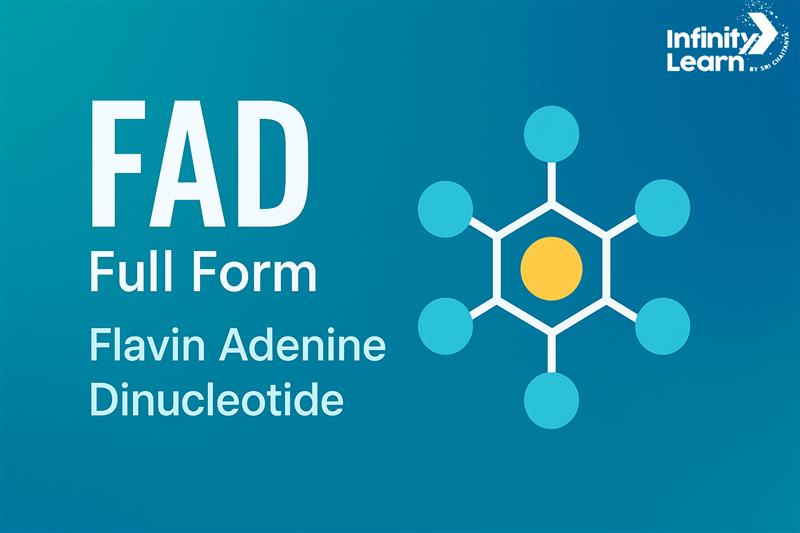Table of Contents
The FAD Full Form is Flavin Adenine Dinucleotide. It is a special substance found in all living things, including humans. It comes from vitamin B2 (also called riboflavin), which we get from our food.
FAD describes a coenzyme, which means it helps other proteins do their jobs in the body. It is essential for turning food into energy, combating stress, and maintaining our cells’ health. Doctors and scientists study FAD to understand diseases, design medicines, and even track how well treatments work. This article explains the FAD Full Form, what it is, how it works, and why it matters.

What is FAD Full Form?
The FAD Full Form is Flavin Adenine Dinucleotide. It is a natural chemical found in living cells. It is made from vitamin B2, also called riboflavin. When our body uses vitamin B2, it changes it into FAD.
FAD Full Form describes a molecule that acts as a “helper” or coenzyme. Coenzymes help enzymes work better. Enzymes are proteins that speed up chemical reactions in the body. Many of these important reactions would not happen properly without FAD.Flavin Adenine Dinucleotide is important for the following:
- Producing energy from the food we eat.
- Helping cells breathe and use oxygen.
- Supporting other chemical reactions in our body.
It is used in many health fields to understand how the body works and to find problems when someone is sick.
Do Check: ABG Full Form
Structure of FAD
The FAD has a very special structure that allows it to do important jobs inside our body. FAD is made up of two main parts:
- Flavin Mononucleotide (FMN): This part comes from vitamin B2 (also called riboflavin). FMN helps in accepting and passing electrons during chemical reactions.
- Adenine Nucleotide (AMP): This part is similar to a piece of DNA or RNA. It contains adenine (a nitrogen base), a sugar (called ribose), and a phosphate group.
These two parts are connected by two phosphate groups. That is why it is called “dinucleotide,” because it has two nucleotides joined together.
The full molecule of FAS has the chemical formula C₂₇H₃₃N₉O₁₅P₂ in scientific terms. That can look hard to read, but it just shows how many atoms are inside one molecule of FAD.
The special shape of FAD helps it fit perfectly into certain proteins, called flavoproteins. These proteins need FAD to work correctly.
There is also a special part of the FAD structure called the isoalloxazine ring. This ring is very important because it can gain or lose electrons. This is what allows FAD to take part in redox reactions, chemical reactions where something is either gaining or losing electrons.
Properties of FAD
The following are the properties of FAD. A molecule’s properties tell us how it behaves, how it looks, and what it can do.
1. Physical Appearance
FAD looks like a white, glass-like crystal when it is pure. It does not have a smell and can dissolve in water. It is also autofluorescent, which means it glows under special light, especially blue or green light. Scientists use this glow to study cells and diseases.
2. Molecular Weight
The total weight of one FAD molecule is about 785.56 grams per mole. This weight is called the molar mass. It helps scientists measure and mix the correct amount of FAD in the lab.
3. Redox States
One amazing thing about FAD is that it can exist in four different forms based on how many electrons it carries. These forms have different names and colors:
- FAD (quinone form): This is the normal, fully oxidized form. It is yellow in color.
- FADH (semiquinone form): This is a half-used form. It can be blue or red, but it is unstable.
- FADH₂ (hydroquinone form) – This is the fully used form. It becomes colorless and stores energy.
- Flavin-N(5)-oxide – This is a special over-oxidized form. It looks yellow-orange.
These color changes are very useful in labs and studies. Scientists can actually “see” what form FAD is in based on color.
Do Check: ACC Full Form
4. Behavior in Reactions
FAD is known for its electron-carrying ability. It takes electrons from one place and gives them to another. This makes it perfect for redox (reduction-oxidation) reactions. These reactions are very common in the body in energy-making processes.
5. Biological Importance
FAD is used in many cell processes, like metabolism, oxygen use, and defense against cell damage.
Role of FAD
FAD plays a vital role in many body processes. Its main job is to help enzymes called flavoproteins work. These enzymes control important reactions that keep us alive and healthy.The following are some of its key roles:
- Energy Production: It helps break down food to release energy in cells. This energy powers everything we do.
- Metabolism: It supports many pathways that turn food into energy or building blocks for cells.
- Oxygen Use: It helps cells use oxygen correctly.
- Defense Against Stress: It fights oxidative stress, which can damage cells.
- Protein Folding: It assists in making sure proteins in the body fold correctly to do their jobs.
- Cell Differentiation: It helps cells grow into their special roles in the body.
- Redox Reactions: It transfer electrons during chemical reactions, which is essential for life.
These processes would not work well without FAD. That is why vitamin B2 is so important in our diet.
Do Check: TBT Full Form
Involvement of FAD
FAD is involved in many metabolism pathways in the body. These are like maps that show how our body changes food into energy and other needed substances.Some important pathways that use FAD are:
- Glutathione Metabolism: It helps produce glutathione, a substance that defends cells against damage.
- Caffeine Metabolism: It helps break down caffeine in the body.
- Amino Acid Degradation: It helps break down proteins (like valine, leucine, isoleucine, and lysine) into energy.
- Folate Metabolism: It is important for making DNA and repairing cells.
- Riboflavin Metabolism: It changes riboflavin (vitamin B2) into FAD itself.
These pathways are essential for life. The body would not be able to create energy, protect itself, or grow properly without FAD.
Clinical Significance of FAD
The FAD is also important in medicine and health. Doctors and scientists study FAD to understand and treat diseases. The following are some clinical points about FAD:
- Vitamin B2 Deficiency: The body can’t make FAD without enough vitamin B2. This can cause health problems like weakness, sore throat, and skin issues.
- Flavoprotein-Related Diseases: Some diseases are linked to low FAD levels. For example, in ALS (a nerve disease), patients may have problems making FAD.
- Drug Design: Scientists target FAD-using proteins in bacteria to make new antibiotics.
- Optogenetics: FAD’s natural light sensitivity helps scientists control cells with light, which is useful in brain research.
- Treatment Monitoring: Doctors can use FAD’s natural glow to watch how well treatments are working, for example, in cancer.
This makes FAD important for our body and for modern medicine and research.
Do Check: IRDA Full Form
FAQs on FAD Full Form
What is FAD Full Form?
It stands for Flavin Adenine Dinucleotide, a molecule made from vitamin B2.
Why is FAD important?
It helps make energy, fight stress, and keep our cells healthy.
Where is FAD found?
It is found in all living cells in our body.
How does our body get FAD?
Our body makes it from vitamin B2 we get in food.









